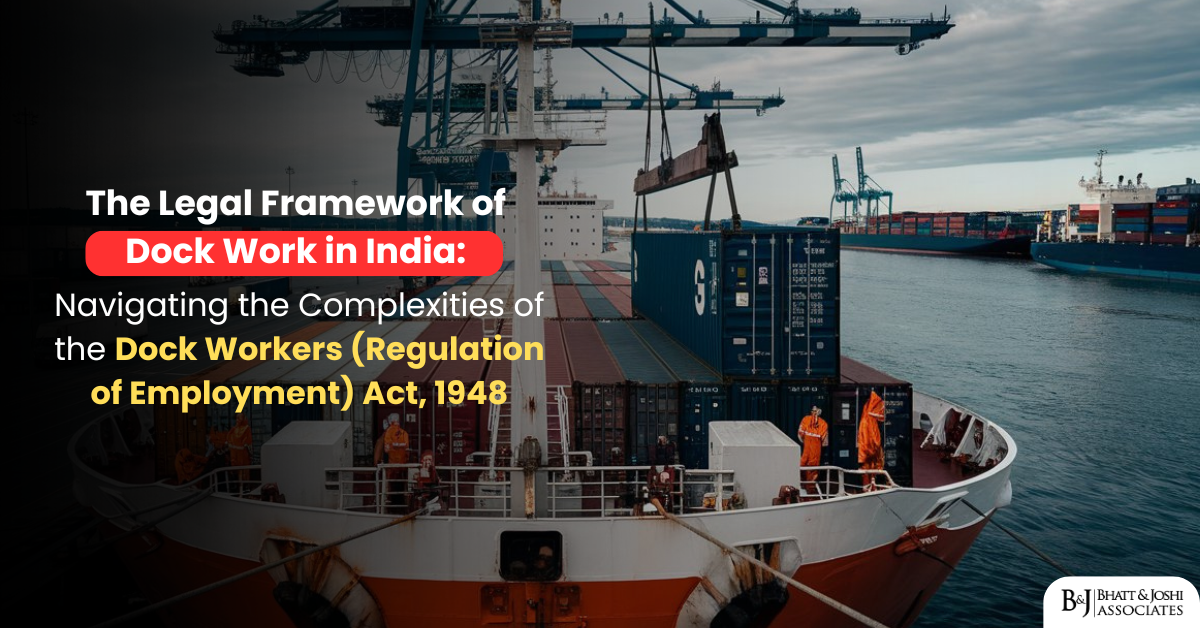Introduction
In the vast tapestry of Indian labor law, there exists a unique and often overlooked piece of legislation that governs a critical yet niche sector of the country’s industrial landscape. The Dock Workers (Regulation of Employment) Act, 1948, stands as a testament to India’s complex labor history and its ongoing struggle to balance worker rights with economic efficiency in its maritime industry. This Act, conceived in the immediate aftermath of India’s independence, continues to shape the employment dynamics of dock workers across the nation’s bustling ports.
The significance of this legislation extends far beyond its immediate subjects. It touches upon fundamental issues of labor rights, economic policy, and India’s position in global trade. As India seeks to modernize its ports and enhance its maritime capabilities, the legal framework established by this Act becomes increasingly relevant, presenting both challenges and opportunities for policymakers, port authorities, and workers alike.
This article delves into the intricacies of the Dock Workers (Regulation of Employment) Act, 1948, exploring its historical context, key provisions, implementation challenges, and its impact on the Indian maritime sector. As we navigate through this complex legal terrain, we will uncover the unique aspects of dock work regulation in India and its implications for the broader industrial landscape.
Historical Context: The Genesis of Dock Work Regulation in India
The origins of the Dock Workers (Regulation of Employment) Act, 1948, can be traced back to the tumultuous period of India’s transition to independence. In the late 1940s, India’s ports were hubs of intense labor activity, marked by frequent strikes and unrest. The dock workers, essential to the country’s maritime trade, often faced precarious employment conditions, with irregular work and unpredictable wages.
The Act was born out of the need to bring stability to this crucial sector and to address the unique challenges faced by dock workers. Unlike factory workers who had relatively stable employment, dock workers faced the vagaries of shipping schedules and seasonal fluctuations in trade. This led to a system of casual employment that left workers vulnerable to exploitation and economic insecurity.
The legislation was also influenced by international trends in dock work regulation, particularly the practices in British ports. However, the Indian Act was tailored to address the specific socio-economic conditions of post-independence India, reflecting a blend of socialist ideals and pragmatic economic considerations.
Key Provisions of the Dock Workers (Regulation of Employment) Act, 1948: A Unique Regulatory Approach
The Dock Workers (Regulation of Employment) Act, 1948, introduced several innovative provisions that set it apart from other labor laws of its time. At its core, the Act sought to regularize the employment of dock workers and ensure fair distribution of work and wages.
One of the most distinctive features of the Act is the concept of a “pool” of registered dock workers. Under this system, all eligible dock workers are required to register with the local Dock Labour Board. The Board then becomes responsible for allocating work among these registered workers, aiming to ensure equitable distribution of employment opportunities.
The Act also mandates the establishment of Dock Labour Boards at major ports. These Boards, comprising representatives from workers, employers, and the government, are entrusted with the crucial task of regulating the employment of dock workers. They are responsible for maintaining the register of workers, allocating work, and addressing disputes.
Another unique aspect of the Act is its provision for guaranteed minimum wages. Registered dock workers are entitled to a minimum wage, even during periods when work is scarce. This provision was revolutionary for its time, providing a safety net for workers in an industry characterized by fluctuating workloads.
The Act also includes provisions for the welfare of dock workers, mandating the creation of welfare funds and the implementation of various social security measures. These include provisions for housing, healthcare, and education for workers and their families.
Implementation Challenges of the Dock Workers (Regulation of Employment) Act, 1948: Navigating Rough Waters
While the Dock Workers (Regulation of Employment) Act, 1948, was progressive in its intent, its implementation has faced numerous challenges over the decades. One of the primary issues has been the tension between the Act’s worker-centric provisions and the evolving needs of a modernizing port sector.
The pool system, while designed to ensure job security and fair work distribution, has often been criticized for its potential to create inefficiencies. Critics argue that it can lead to overstaffing and reduce the flexibility needed in a dynamic global shipping environment. This has led to ongoing debates about the balance between worker protection and operational efficiency in Indian ports.
Another challenge has been the adaptation of the Act to technological changes in the shipping industry. The advent of containerization and automated cargo handling systems has significantly altered the nature of dock work. This has necessitated a reinterpretation of the Act’s provisions to accommodate these technological advancements while still protecting worker interests.
The implementation of the Act has also been affected by regional variations. While the Act applies to major ports across India, its application and interpretation can vary significantly between different port cities, leading to inconsistencies in labor practices and worker benefits.
Moreover, the existence of a large informal workforce in many Indian ports, operating alongside the registered dock workers, has created a dual labor market. This has posed challenges in terms of ensuring comprehensive coverage of worker protections and maintaining equitable working conditions.
Legal Interpretations and Landmark Judgments on the Dock Workers (Regulation of Employment) Act, 1948
Over the years, the Dock Workers (Regulation of Employment) Act, 1948, has been subject to numerous legal interpretations and judicial pronouncements. These have played a crucial role in shaping the practical application of the Act and addressing its ambiguities.
One landmark case is the Port of Bombay v. Dock Labour Board (1966), where the Supreme Court of India deliberated on the extent of powers vested in the Dock Labour Boards. The Court’s decision affirmed the broad regulatory authority of these Boards while also emphasizing the need for their decisions to be reasonable and in line with the Act’s objectives.
Another significant judgment came in the case of Mackinnon Mackenzie & Co. Ltd. v. Audrey D’Costa (1987), which, although not directly related to dock workers, had implications for the interpretation of labor laws in the maritime sector. The Court’s ruling on equal pay for equal work set a precedent that influenced subsequent interpretations of the Dock Workers Act, particularly in matters of wage determination and gender equality.
The judiciary has also grappled with the question of the Act’s applicability to newly developed ports and private terminals. In cases like Gangavaram Port Limited v. Union of India (2013), courts have had to balance the Act’s original intent with the changing realities of port development and privatization.
The Act in the Modern Context: Adaptation and Reform
As India’s maritime sector undergoes rapid modernization and expansion, the relevance and efficacy of the Dock Workers (Regulation of Employment) Act, 1948, have come under increased scrutiny. The government has initiated several measures to reform and adapt the Act to contemporary needs.
One significant development has been the gradual move towards decasualization of dock work. This process aims to provide more stable employment to workers while allowing ports greater flexibility in workforce management. However, this transition has been complex, often leading to labor disputes and necessitating careful negotiation between worker unions, port authorities, and the government.
The government has also been working on harmonizing the provisions of the Act with other labor laws and economic policies. This includes efforts to align dock work regulations with broader initiatives like the ‘Ease of Doing Business’ and the development of coastal economic zones.
There have been discussions about introducing more flexibility in the allocation of work and allowing for a greater role for private operators in workforce management. These proposals, however, have often faced resistance from worker unions, highlighting the ongoing challenge of balancing worker rights with operational efficiency.
Another area of focus has been the enhancement of skill development programs for dock workers. Recognizing the changing nature of port operations, there have been initiatives to retrain and upskill workers to adapt to new technologies and work practices.
International Comparisons and Global Best Practices
The regulation of dock work in India, as embodied in the 1948 Act, presents an interesting case study when compared to international practices. Many countries have grappled with similar issues of balancing job security for dock workers with the need for operational flexibility in ports.
For instance, the United States underwent a significant transformation in dock work regulation with the Longshore and Harbor Workers’ Compensation Act, which has been amended several times to adapt to changing industry dynamics. The European Union has also seen efforts to liberalize port services while maintaining strong worker protections, as evidenced by the ongoing debates surrounding the Port Services Regulation.
Australia’s waterfront reform in the late 1990s offers another point of comparison. The reforms aimed at increasing productivity and reducing overstaffing in ports, leading to significant changes in work practices and employment arrangements for dock workers.
These international experiences offer valuable insights for potential reforms in India. They highlight the global trend towards greater flexibility in port operations while underscoring the importance of safeguarding worker interests in the process of modernization.
Future Outlook: Charting a Course for Reform
As India looks to enhance its position in global maritime trade, the future of dock work regulation stands at a crucial juncture. The Dock Workers (Regulation of Employment) Act, 1948, while historically significant, faces the challenge of adapting to a rapidly evolving industry landscape.
One potential area of reform is the modernization of the worker registration and allocation system. There are proposals to leverage technology to create more efficient and transparent mechanisms for work distribution, potentially replacing the traditional pool system with a more dynamic model.
Another area of focus is likely to be the enhancement of social security measures for dock workers. This could involve the creation of more comprehensive welfare schemes and the integration of dock workers into broader social security networks.
The increasing automation of port operations presents both challenges and opportunities. Future reforms may need to address the redeployment and reskilling of workers affected by automation while ensuring that the benefits of technological advancements are shared equitably.
There is also a growing recognition of the need to address environmental concerns in port operations. Future amendments to the Act may incorporate provisions for environmental protection and sustainable practices in dock work.
Conclusion
The Dock Workers (Regulation of Employment) Act, 1948, stands as a unique piece of legislation in India’s industrial law landscape. Its journey from a post-independence measure to regularize dock work to its current status in a modernizing maritime sector reflects the broader evolution of India’s labor laws and economic policies.
The Act’s distinctive features – the pool system, the role of Dock Labour Boards, and its provisions for minimum wage guarantees – have played a crucial role in shaping the working conditions in Indian ports. However, these very features have also been the subject of ongoing debates about their relevance and efficacy in a changing global context.
As India seeks to position itself as a major player in international maritime trade, the regulation of dock work will continue to be a critical area of focus. The challenge lies in finding a balance between protecting worker rights, ensuring operational efficiency, and fostering innovation in port operations.
The future of dock work regulation in India will likely involve a careful recalibration of the Act’s provisions to meet the demands of a modern, technology-driven port sector while upholding the principles of worker welfare and equitable employment practices. This process will require collaborative efforts from policymakers, port authorities, worker representatives, and industry stakeholders.
In conclusion, the Dock Workers (Regulation of Employment) Act, 1948, remains a testament to India’s complex labor history and its ongoing efforts to navigate the challenges of economic development and worker protection. As the country charts its course in the global maritime landscape, the evolution of this unique piece of legislation will continue to be a subject of significant interest and importance.














